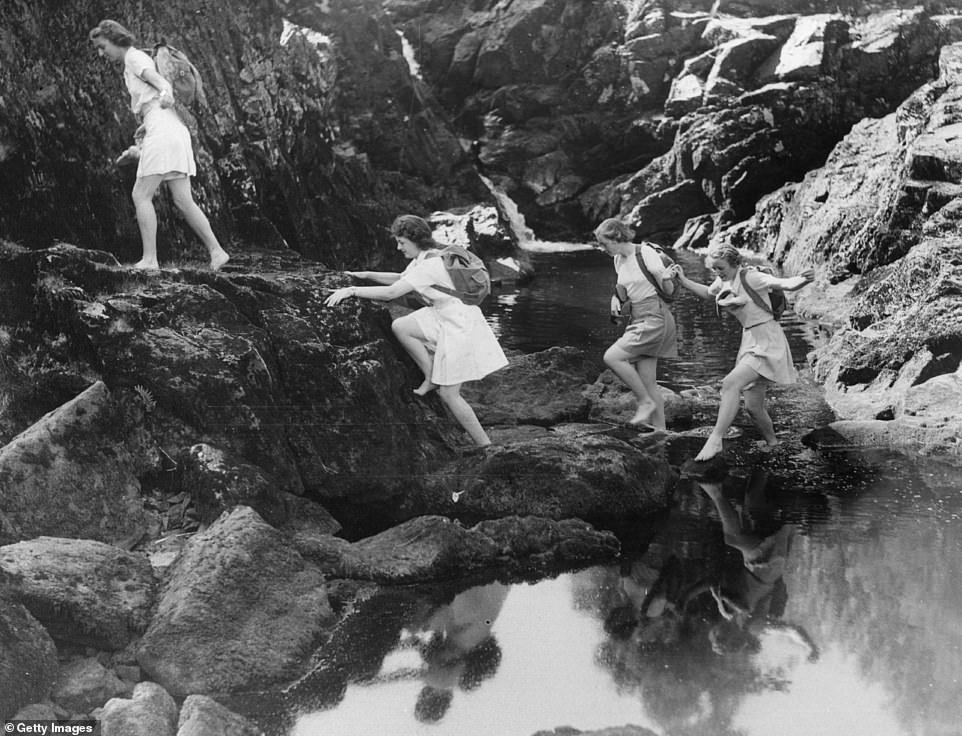Covering 912 square miles (2,362 square kilometers), the Lake District is England’s largest national park – and its most popular, with more than 19 million visitors each year.
Even though it has been loved for generations.
In 1820 the famous poet William Wordsworth published ‘A Guide to the Lakes’ and once described his home in Grasmere as ‘the loveliest place that man found’.
The region initially attracted wealthy tourists, with the advent of the railway – and the station at Lake Windermere – helping to make it more accessible to those from a wider range of backgrounds.
Then the M6 accelerated the park to mass tourism hotspot status in the late 1950s and 1960s.
These photos take you back to a simpler, less crowded time…let us know in the comments which place you love the most.

This image depicts walkers at Skelwith Falls near Ambleside circa 1930. The Lake District National Park says: ‘From the late 18th century the land was no longer seen only as a means of making a living through agriculture or industry. People began to recognize its beauty’

Women are pictured here in 1933 diving in the outdoor Grange pool near Arnside, a village right at the southern tip of the Lake District. The swimming pool was built in 1932, but was closed in 1993

Holidaymakers are pictured on one of the Grange Pool’s water slides in 1933. The Save Grange Lido campaign explained that the ‘Lido (has) remained closed and gradually decaying’ since its closure despite calls to restore it

LakeLovers.co.uk says that the extension of the railway and the opening of Windermere station in the 1840s ‘gave many more people the opportunity to visit the region’. Above – people in Tilberthwaite, north of Coniston Water, in 1933

Three women on holiday in the Lake District in 1934. By this time the Lake District’s ‘scenic qualities’ had been ‘inspiring literature and art’ for decades. Prominent fans of the region included William Wordsworth, Beatrix Potter and John Ruskin

In this photo, men are photographed shearing longwool sheep at a remote farm in Bannisdale in 1939. Sheep farming remains important in the region today. Visit Cumbria notes: ‘Cumbria without sheep wouldn’t be Cumbria’

Three walkers are snapped resting and dipping their feet into Blea Tarn Lake in 1940. It is still a popular scenic spot today and Visit Cumbria describes it as one of the ‘easiest’ places to visit in the Lake District

A group of youth hostel guests are captured in the Lake District in 1941. The Youth Hostel Association says hostels ‘gave young working people an unprecedented opportunity to spend leisure time in fresh air and open countryside, on a scale previously only possible for the wealthy’

This photograph, which dates from 1948, shows farmers gathering hay in Langdale. The original caption read: ‘On a clear autumn day, in an environment world-renowned for its beauty, the last haymaking is carted away’

Fishermen are caught ‘bringing in a fresh batch of perch’ from Windermere, England’s largest lake, in 1948. Perch were considered a pest and were removed from the lake to increase the numbers of trout and char

This image captures Bridge House, ‘possibly the most photographed building in the Lake District’, in 1950. Visit Cumbria explains that the house in Ambleside was a ‘popular subject for many artists, including Turner’. Once an apple store, the house was built over the bridge to avoid land tax. Nowadays it belongs to the National Trust

The Lake District National Park was formed in 1951 and became the second national park in the United Kingdom after the Peak District. These cyclists are photographed consulting their map along Grasmere in 1953

A group of walkers pose on stepping stones near Rydal village in 1957. The establishment of the area as a national park ‘attempted to preserve its special characteristics and limit threats to the landscape’, explains lakedistrict.gov.uk

Derwentwater, aka the ‘Queen of the Lakes’, in the winter of 1959. This lake is home to four islands and one of the area’s finest views, from a rocky promontory called Friar’s Crag

Tourists viewing Tarn Hows in 1960, a man-made beauty spot which is ‘now a favorite spot for walkers of all ages and abilities’, according to Visit Lake District

A shop in the village of Rosthwaite in the 1960s. The Lake District National Park website explains: ‘Improvements in the roads, widespread car ownership and rising living standards led to an ever-increasing number of visitors from the 1960s’





